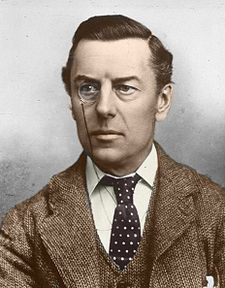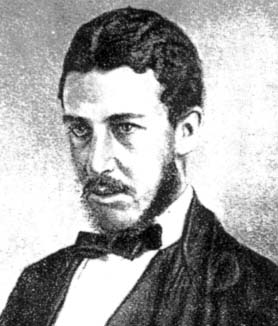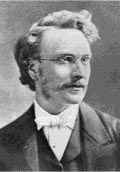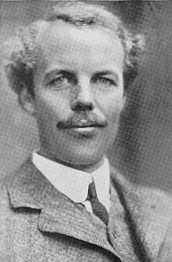The Keynesian “Revolution”
![]()
By David McDonagh
John Maynard Keynes (1883-1946) was not really sympathetic to the idea of revolution but he certainly wanted a new beginning in economics, if not in society. Economics, as he found it, exasperated him exceedingly. So did businessmen. Many classical liberals are exasperated by businessmen too, for the statists are right to say that “the market is a good servant but a poor master”. But a free people do not want a master! Yet if we are to get freedom it will not be by servile entrepreneurship but by bold propaganda. We need to make the people think rather than pander to how we find them.

Joseph Chamberlain
What Keynes disliked most about the economic theory that he found was its general, if unwitting, disregard of politics. Keynes realised he was one of an elite and he thought that rulers had merit. The pandering of the market to the public outlook was not good enough for him. More respect needed to be paid to the state. Although not a socialist of any sort, Keynes did sympathise with the changes that Joseph Chamberlain made generational in the Liberal Party of the 1880s. They effectively made Gladstone the last classical liberal and constituted the real death of liberal England by the adoption of state management that many, if not Keynes, would consider to be nearer to socialism than to pristine liberalism. After failing to marry Chamberlain, Beatrice Potter, later a close friend of Keynes, married Sydney Webb instead. They ran the Fabian Society that adopted gradualism in politics, an outlook that suited Keynes perfectly. He did not want to reach the Marxist ideal of the moneyless society, even though the Fabians retained that idea, if only as an unrealistic ideal. Keynes certainly saw that it was unrealistic. He was fairly confident that it never would be fully realised, but he did welcome some state ownership; as did the Liberal Party that he was a lifelong member of and that remains the case from the 1880s to the present.
Gradualism is the Fabian idea that we can approach moneyless socialism, bit by bit. The EU have adopted a similar, if not the same idea, with their aim at the European superstate. The Fabian Society rejected revolution and so did Keynes, even in what we call the Keynesian “Revolution”; but he nevertheless, traded on that romantic meme. It might not make a clean beginning in fact, but it would mark a change of fashion in ideas, of what was thought to be up to date and what was considered to be old hat. In fitting with Thomas Kuhn’s outlook on scientific revolutions, Keynes aimed for a paradigm change. The ideas he opposed would be rendered very easy to oppose, as they would be discredited by a change of fashion. But Keynes felt that the market society was here to stay, and that his aims would not alter everyday life very much at all. The movement towards socialism in the moneyless Fabian ideal was held to be not a real destination at all but merely a delusion that provided a journey that would never end; one that Keynes was ready to accept as an end in itself. Keynes effectively just wanted to replace the investors or the rich businessmen by the state. He did not expect that to change normal life much.
But Keynes did not only accept the changes of the 1880s, the decade of his birth, in the Liberal Party. The 1870s had earlier seen the marginal revolution in economics, where Marx witnessed those he called the “vulgar” economists replace those he championed as “the classical economists”. The latter held to various theories of an underlying reality largely based on labour inputs or costs of production that Marx thought to be truly scientific. Marx had adopted, and then adapted the ideas of Adam Smith and his epigones up to John Stuart Mill to his own outlook. But Marx rejected those authors who held that supply and demand was enough without an underlying basis, as they seemed to him to be superficial and unscientific. He called such authors “vulgar” as they had no objective value theory and they tended to accept things on mere appearance. Marx went with the majority in backing “the classical economists” as they were well ahead of those he called the vulgar economists in prestige in the 1840s. The events of the 1870s showed that he had backed the wrong horse after all. The labour theory of value is the idea that only labour, or work, truly confers value. But even Marx held there was something of worth in nature e.g. wild fruit. This paradigm of the labour theory of value was replaced in the 1870s by the idea that there was no need to look behind demand to the cost of production, or any idea of the objective value, as we could more realistically look to how customers valued the wares on offer, i.e. subjective value, not the supply of given goods or services as a whole, but only by bits of the wares or services on the margin. This was marginal theory. For example, we do not value, or ever drink, all the water there is but just a glass of water at any one time. This glass of water is on the margin of water as a whole; a practical helping rather than the mere abstraction of water itself.

William Stanley Jevons
One of the originators, William Stanley Jevons, explained the marginal theory thus:
“We must now carefully discriminate between the total utility arising from any commodity and the utility attaching to any portion of it. Thus the total utility of the food we eat consists in maintaining life, and may be considered as infinitely great; but if we were to subtract a tenth part from what we eat daily, our loss would be but slight. We should certainly not lose a tenth part of the whole utility of food to us. It might be doubted whether we should suffer any harm at all.
Let us imagine the whole quantity of food which a person consumes on an average during twenty-four hours to be divided into ten equal parts. If his food be reduced by the last part, he will suffer but little; if a second part be deficient, he will feel the want distinctly; the subtraction of the third part will be decidedly injurious; with every subsequent subtraction of a tenth part his sufferings will be more and more serious, until at length he will be on the verge of starvation. Now, if we call each of the tenth parts an increment, the meaning of those facts is that each increment of food is less necessary, or possesses less utility, than the previous one.”
[Cited by Edwin Cannan in Wealth (1914) p110]
The idea was that we only value the bits of the various things that we can practically use. We can never eat food, or drink, as a whole, for that is a mere abstraction, but only this particular egg, or that particular cup of tea.
Competition could be left to deal with the costs of production. Entrepreneurship might make a big killing, in the short run, if it successfully innovates; but soon other firms will come in to share the profits till the price of the output gets ever nearer to the cost of production.
This tripartite contribution of Jevons (1835-82), Walras (1834-1910) and Menger (1840-1921) introduced basically the same theory, discovered independently in England, Switzerland and Austria, and utterly ended the earlier cost of production theories that were dominant before 1870. Keynes sought a similar change to render the economists of the 1930s defunct. Keynes’s teacher, Alfred Marshall (1842-1924), claimed to be a fourth discoverer of marginal theory, but he wanted to reconcile it with the older economic theory of the cost of production to a far greater degree than did the other three above-mentioned men.
Keynes attempted, in the 1930s, to bring about a similar change of fashion to that achieved in economics in the 1870s. This was laid out in the book he called The General Theory of Employment, Interest and Money (1936). He thought up a cavalier way of shutting all the earlier economists up, and it more or less worked. He would use what he called a “solecism” by which he referred to his actual anachronism of calling all the economists up to 1936 by Marx’s name of “the classical economists”. Keynes used the term “the classics”, seeking to make them as defunct as those before 1870 had been rendered by marginal theory. The use of this special “solecism” meme was the major part of what is referred to as the Keynesian Revolution. It resulted in the likes of Hayek being completely discredited within economics.
I will now say something about the myth of “revolution” in general. The word “revolution” is today a bit of romance jargon, and Keynes realised this, but he felt a dire need to make “the classics” defunct. He saw economic theory as part of the problem, not only of mass unemployment but also of what he took to be the barbaric anarchy of modern times. Keynes knew there could be no actual fresh beginning, but something like one seemed to be needed. “Revolution” is actually just empty jargon, a constituted blank, which is often imposed on an account of the facts by the romantically inclined historians. When the vicar finds out that a couple indulges in sex before marriage he feels he has discovered yet another instance of sin, but the idea that it is a sin is part of his ideology rather than the facts he has discovered about the couple in question. Similarly, when an historian finds what he calls “a revolution”, it is not in the facts but in his romantic mind.
The jargon word “revolution” clearly has a history of its own, and it was first used by the Whigs in 1688. It was taken from geometry, and it was, back then, used in the exact opposite of how it was used from 1789 on by the Romantics and how it is still largely used today. It was used to mean a return to the beginning of the drawing of a circle, to complete the revolution, and this meant exactly the same as “reactionary”, i.e. a reaction against some recent innovation and an attempted return to the status quo ante. The idea in 1688 was that James II had gone one half of a revolution away from how things should be, and that society needed to go back to how things were before he reigned. But in 1789 in France, the idea emerged with a new meaning. This was more akin to going off on a tangent than in completing a revolution, for it introduced the current meaning of going on to a new epoch and leaving the past completely behind. But Keynes was right to think that gradualism was bound to be the case and that no event ever makes for a completely new beginning.

Philip Henry Wicksteed
Keynes wanted to revive the term ‘political economy’. Ironically, his teacher Alfred Marshall whilst attempting to marry the old cost of production theories to the new marginal theories happened to have called his book The Principles of Economics (1890). This seemed to cause the term of ‘political economy’ to fall out of usage, even when extreme marginal theorists, like P.H. Wicksteed (1844–1927) in The Common Sense of Political Economy (1910), retained the label that Marshall had doomed to drop out of use. Keynes’s recent biographer has attempted to revive the old label in his chair at the University of Warwick, as Robert Skidelsky is now the Professor of Political Economy there. Nearly all Keynesians would like to see that older label revived but, oddly, it seems to be dead. It was exactly the idea that economics was independent of politics that both Marx and Keynes abhorred.
Marx wanted to get rid of money, as it ruled out overall planning, but Keynes did not accept that. Keynes thought that the monopoly of money by the state could be used to control the economy. I think here Marx was right that it could not be. He never could say this to Keynes but he said it often enough about some of his forerunners. If Marx was right on Keynes then Keynes was also right on Marx. Money would always be needed and could not be dispensed with in the future as Marx imagined and as the Fabian Society retained in theory.
Keynes had a few new terms for old ideas. The main one is that of demand management. Demand management is the idea that inflation stimulates demand so that the state can use the monopoly it has in money to cure mass unemployment by lowering real wages. All the older economists tended to hold that the workers could price themselves into jobs, but Keynes thought that this would never work, as it would lower effective demand. However, if money was used to boost demand then the wage-rises that the workers achieved might still result in lower real wages, even though that might be higher in money, or in nominal terms. On its own the market would never clear, Keynes held, but with overall demand management by the state it could.
Keynes rejected the idea of equilibrium most of all but, like the old Roman Quintus Fabius Maximus Verrucosus Cunctator in reaction to the powerful Cartherginian general, Hannibal, did not criticise this powerful idea head on. Instead, Keynes used Fabian tactics to attack the more recondite Say’s Law of markets, which held that only output can stimulate general demand. Keynes adopted a new reading for this that cut out the need for entrepreneurship viz. that “supply creates its own demand”. From this he argued that all the earlier economists implicitly held that mass unemployment was impossible, as the match between supply and demand was automatic. In fact, they actually held that it took some entrepreneurship to make that match.
Keynes was far more dashing than his opponents, and very soon the younger economists wanted to side with him. There was also the obvious problem of mass unemployment that aided any theory that promised a solution. But even the brightest of the young economists did not always see what Keynes was getting at. The version of his theory in the textbooks was pioneered by John Hicks, who took it for granted that equilibrium was at the heart of it. Yet that was exactly that that Keynes thought was bogus and what he wanted to get rid of. It was what he thought he might get rid of by an indirect attack. In that sense, the end that Keynes sought actually was not reached. But he did introduce a lot of what is now called ‘macro-economics’, which allows for the semblance of demand management by the state. The older theory that he abhorred largely still survives as ‘micro-economics’.
The major fault with Keynesian theory is that inflation, or demand management, cannot truly stimulate the economy at all, but does distort economic activity even when it fails to boost it. Inflation can ironically only lower effective demand, as it messes up money as a means of exchange, and thus of economic calculation in the mass urban society. All this was explained by these whom Keynes called “the classics”, viz. nearly all the other economists writing in 1936, but Keynes rendered them defunct by use of the “solecism” meme, and all their explanations were discredited and so effectively overlooked.

Arthur Cecil Pigou
It is fairly clear from reading the 1936 book that Keynes is largely attacking only one author, Arthur Cecil Pigou (1877-1959), and only other economists in so far as they agree with Pigou. He has no need for an anachronism, or a “solecism”, at all to do that. But Keynes clearly wants to say it is “the classics” that he rejects – he wants a revolution in theory to render his variously differing forerunners utterly defunct. And what he says, even of Pigou, ignores many things that Pigou says in The Theory of Unemployment (1933) – cited repeatedly by Keynes in this 1936 book. Pigou repeatedly mentions the term “involuntary unemployment” in that 1933 book but Keynes repeatedly says that none before him had even thought of that concept. And in the special meaning he gave to it, he was right. He claims that the classical idea of Say’s Law renders such unemployment impossible, but it did nothing of the kind, in the normal understanding of that idea. So the mass unemployment of the 1930s was held to have refuted economic theory. This story of Keynes was not one iota true, but rival attempts at explanation of mass unemployment were going to be out of fashion for a long time to come. They have not fully been given a chance ever since.
![]()

Top 50 books of all time : by Old Hickory:-
"I have limited the selection to the books I have read. I keep to the norm of not recommending to others books I have yet to read. Clearly, books I have not read by now suggests a judgement of some sort."
PDF version
of this article
![]()
Download
Requires Adobe Acrobat Reader. This is available
for free at www.adobe.com
and on many free CDs.

The Alternative
Bookshop
Which specialises in,
but does not limit itself
to, books on Liberty
and Freedom ... Book
reviews, links,
bestsellers, rareties,
second— hand,
best price on books,
find rare books.
|
|
|
|
|